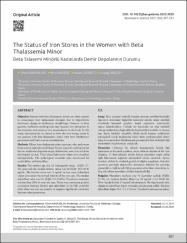The Status of Iron Stores in the Women with Beta Thalassemia Minor
Özet
Objective: Patients with beta-thalassemia minor are often exposed to unnecessary iron replacement therapies due to hypochrome microcytic change in erythrocyte morphology. However, in these patients, ineffective erythropoiesis may increase iron absorption in the intestines and excessive iron accumulation in the body. In this study, retrospectively, we aimed to show the iron storage status in our patients with beta-thalassemia minor with both biochemical parameters and bone marrow examinations. Methods: Fifteen beta-thalassemia minor patients, who underwent bone marrow aspiration and biopsy for any reason in our hospital but had no additional diagnosis except thalassemia, were detected from the hospital records. Their related laboratory values were examined retrospectively. The pathological materials were reevaluated for erythroblast, and sideroblast. Results: The median age was 43 [interqurtile range (IQR): 27- 54] years and the median ferritin values was 24 (IQR: 14.1-84.8) ng/mL. The ferritin values was 15 ng/mL in four cases. Sideroblast values were under the normal limit in all but one case. The median sideroblast value was 6% (IQR: 1.5-15.0%). Transferrin saturation was less than 20% in only one case. There was a moderate positive correlation between ferritin and sideroblast (r=+0.598; p=0.032) while there was not any positive or negative significant correlation between other parameters. Conclusion: In this study, where iron storage status was examined both biochemically and histopathologically, 66% of cases with iron deficiency could have been overlooked if the iron status of the patients was evaluated only by the serum iron panel. The examination of bone marrow aspiration with prussian blue is a gold standard method for determining iron storage status.
Cilt
9Sayı
4Bağlantı
https://doi.org/10.14235/bas.galenos.2020.3959https://search.trdizin.gov.tr/yayin/detay/493244
http://hdl.handle.net/11446/4646


















